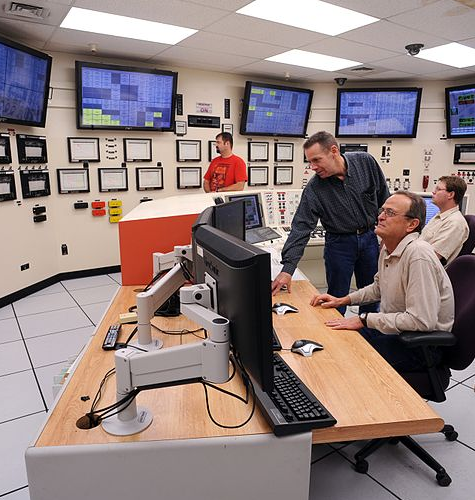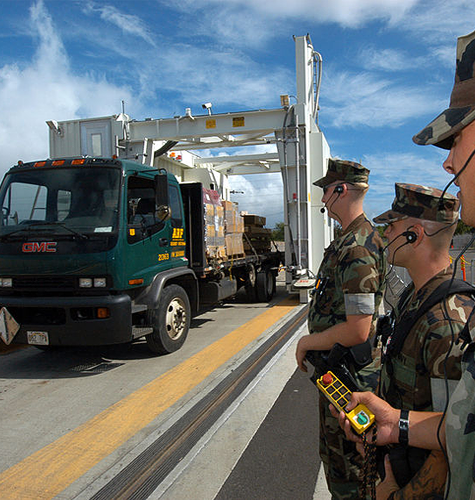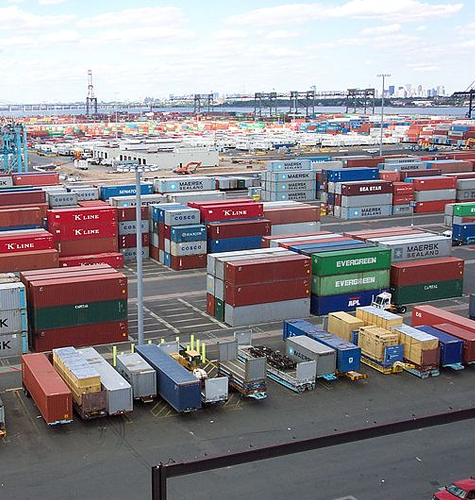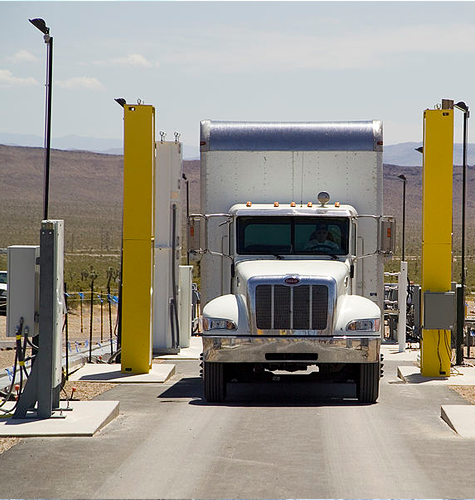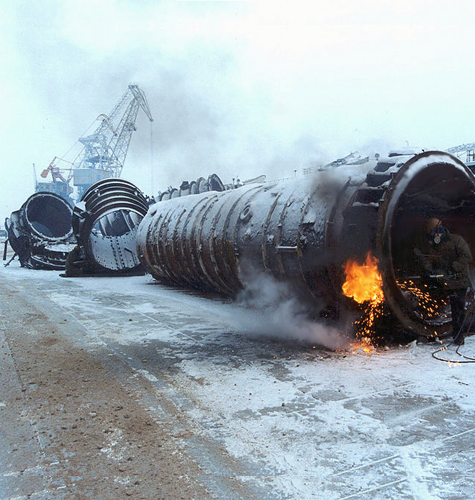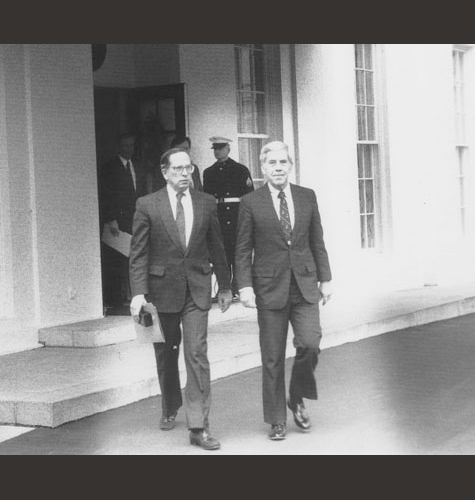1. How does the U.S. government prevent nuclear proliferation and reduce the threat of nuclear terrorism?
Many organizations within the U.S. government undertake nuclear nonproliferation activities. A key component of the nonproliferation mission is nuclear threat reduction—preventing nuclear weapons, materials, technology and expertise from falling into the wrong hands.
U.S. threat reduction programs reduce and eliminate the risks posed by unsecured or poorly secured nuclear weapons and weapons-usable nuclear materials, including highly enriched uranium and plutonium.
Today, U.S. threat reduction programs are in place worldwide to:
- eliminate nuclear weapons and weapons-usable materials
- secure weapons and material at storage sites and in transit to prevent theft and sabotage
- counter proliferation when nonproliferation efforts fail
Many threat reduction programs engage in more than one of these activities.
Program Spotlight: Threat Reduction Examples
2. Which U.S. government departments and agencies are responsible for nonproliferation and nuclear threat reduction activities?
DoD, NNSA, and the State Department play the largest roles in nonproliferation and threat reduction and oversee the most significant programs. The Department of Homeland Security and the Department of Commerce also play key roles.
| Agencies | Major Threat Reduction Activities and Programs |
|---|---|
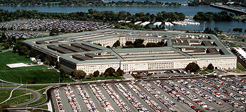 The Pentagon, Source: Department of Defense via WikiMedia Commons |
The Department of Defense (DoD) works with other countries to secure vulnerable nuclear weapons and weapons-usable materials, and to eliminate retired weapons systems. Projects funded by DoD’s Cooperative Threat Reduction (CTR) program include:
|
 NIF Laser Bay, Source: Lawrence Livermore National Laboratory |
The Department of Energy’s National Nuclear Security Administration (NNSA) works cooperatively to secure materials and facilities, both abroad and at home; to convert reactors from directly weapons-usable HEU to low enriched uranium (LEU) fuel; and to provide for the disposition of surplus weapons-usable nuclear materials.
|
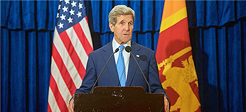 Secretary Kerry Delivers Speech, Source: Department of State |
The State Department is responsible for negotiating arms control and reduction agreements; overseeing export control and border security assistance programs; and implementing the Proliferation Security Initiative, in cooperation with partner states.
|
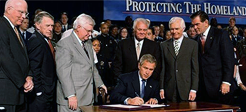 President George W. Bush signs the Homeland Security Appropriations Act of 2004, Department of Homeland Security via WikiMedia Commons |
The Department of Homeland Security (DHS) manages programs to scan cargo for radioactive materials at overseas ports with cargo destined for the United States. DHS is also responsible for detecting nuclear or other radioactive materials inside the United States.
|
 Former Secretary of Commerce Ron Brown, Source: Department of Commerce |
The Department of Commerce establishes and monitors export controls to prevent the illicit acquisition of proliferation-sensitive technologies. |
3. What percentage of the nuclear budget is dedicated to these programs?
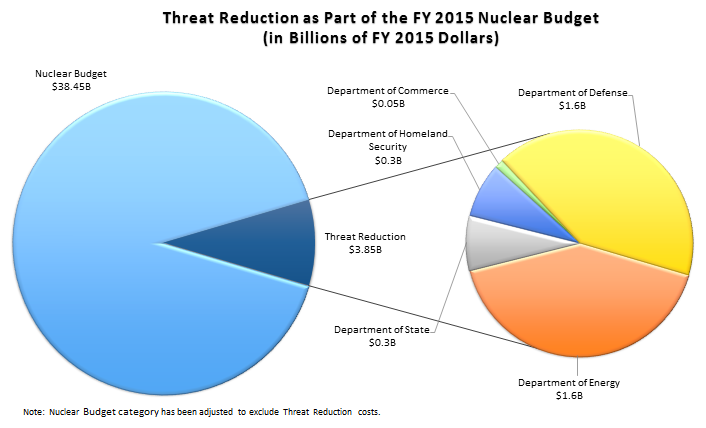
Less than 10 percent of U.S. annual nuclear spending is allocated to securing nuclear materials and preventing nuclear terrorism.
Despite President Obama’s early emphasis on nuclear security, and his administration’s self-imposed goal of securing all nuclear materials from terrorists, the FY2014 and FY2015 budget requests cut funding for securing nuclear materials by approximately 21 percent. [13] These cuts came at the same time as a significant increase in spending on U.S. nuclear weapons. [14]
The Obama administration has defended the nuclear security component of its budget requests, saying that many key nuclear security objectives have already been met, but many outside experts disagree. [15]
4. Are these programs cost effective?

Left to right:
1. Vietnam HEU removal, source: Flickr; 2. HEU awaiting secure transportation by rail, source: NNSA
3. Removal of fresh HEU from Ukraine in 2010, source: NNSA; 4. 2010 Nuclear Security Summit, source: The Kremlin
5. Vietnam HEU removal, source: NNSA.
Given the consequences of a nuclear terrorist attack, most officials and experts agree that the benefits of programs to mitigate the risk of nuclear terrorism far outweigh the financial costs. [16] If terrorists get access to a nuclear weapon or to weapons-usable nuclear materials, carrying out an attack becomes much harder for governments to prevent.
Nuclear and other radioactive materials are extremely difficult to detect, and given the volume of global trade and technical detection challenges, finding them is immensely difficult. For this reason, the cost effectiveness of projects like NNSA’s Nuclear Smuggling Detection and Deterrence (formerly Second Line of Defense) program, which installs radiation detectors at border crossings and seaports, is highly debated. For fiscal year 2016, the House Armed Services Committee recommended a budget of $336.8 million dollars for this program, a $90 million decrease from the previous year. [17]
Sources
[1] United States Department of Energy, “Material Management and Minimization,” NNSA, accessed June 15, 2016. https://nnsa.energy.gov/aboutus/ourprograms/dnn/m3
[2] As announced by Brian Waud (NNSA) at RRFM/IGORR 2016 (European Research Reactor Conference), March 14, 2016, Berlin.
[3] United States Department of Energy, “Global Material Security,” NNSA, accessed 2016. https://nnsa.energy.gov/aboutus/ourprograms/dnn/gms
[4] United States Department of Energy, “International Nuclear Security,” NNSA, accessed 2016. https://nnsa.energy.gov/aboutus/ourprograms/ dnn/gms/ins
[5] “Ukraine to Accept U.S. Nuclear Smuggling Detection Equipment,” Açik Radyo 94.9, accessed 2016. http://acolradyo.com.tr/arsiv-icerigi/ukraine-accept-us-nuclear-smuggling-detection-equipment
[6] United States Department of Energy, “Megaports Initiative,” NNSA, United States Department of Energy, last modified 2010. http://nnsa.energy.gov/aboutus/ourprograms/nonproliferation/programoffices/internationalmaterialprotectionandcooperation/-5
[7] United States Department of Energy, “Megaports Initiative,” NNSA, United States Department of Energy, last modified 2010, accessed 2016. http://nnsa.energy.gov/aboutus/ourprograms/nonproliferation/programoffices/internationalmaterialprotectionandcooperation/-5
[8] “Combating Nuclear Smuggling: Megaports Intitiative Faces Funding and Sustainability Challenges,” GAO, accessed July 15, 2016. http://www.gao.gov/assets/650/649759.pdf
[9] Department of Defense, “Defense Threat Reduction Agency,” DTRA, United States Department of Defense, last modified 2015, accessed 2016. http://www.dtra.mil/Research/NuclearTechnologiesDepartment.aspx; United States Department of Homeland Security, “Domestic Nuclear Detection,” DHS, last Modified 2015, accessed 2016. https://www.dhs.gov/domestic-nuclear-detection-office.
[10] “The Nunn-Lugar Cooperative Threat Reduction Program Fact Sheet,” American Security Project, July 25, 2012, http://www.americansecurityproject.org/fact-sheet-the-nunn-lugar-cooperative-threat-reduction-program-securing-and-safeguarding-weapons-of-mass-destruction/
[11] Center for Arms Control and Non-proliferation, “Fact Sheet: The Nunn-Lugar Cooperative Reduction Program,” last modified 2014, accessed 2016. http://armscontrolcenter.org/fact-sheet-the-nunn-lugar-cooperative-threat-reduction-program/
[12] “The Evolution of Cooperative Threat Reduction: Issues for Congress,” Federation of American Scientists, accessed July 15, 2016. https://www.fas.org/sgp/crs/nuke/R43143.pdf
[13] Matthew Bunn, Nickolas Roth, and William H. Tobey, Cutting Too Deep: The Obama Administration’s Proposals for Nuclear Security Spending Reductions. (Cambridge, MA: Project on Managing the Atom, Belfer Center for Science and International Affairs, Harvard Kennedy School, July 2014).
[14] Douglas Birch, “Obama curbs nuclear security goals as bomb-building budget grows,” The Center for Public Integrity, July 29, 2014.
[15] Matthew Bunn, Nickolas Roth, and William H. Tobey, Cutting Too Deep: The Obama Administration’s Proposals for Nuclear Security Spending Reductions. (Cambridge, MA: Project on Managing the Atom, Belfer Center for Science and International Affairs, Harvard Kennedy School, July 2014).
[16] Matthew Bunn, Securing the Bomb 2010: Securing All Nuclear Materials in Four Years.(Cambridge, MA and Washington, DC: Project on Managing the Atom, Harvard University, and the Nuclear Threat Initiative, April 2010)
[17] “House Report 114-102 – National Defense Authorization Act for Fiscal Year 2016,” Library of Congress, accessed April 2016. http://thomas.loc.gov/cgi-bin/cpquery/?&sid=cp114cT0f3&r_n=hr102.114&dbname=cp114&&sel=TOC_1289771&
Chart Sources
[1] Threat Reduction as a Part of the Nuclear Budget: Center for Arms Control and Non-Proliferation, “FY 2017 Budget: Nuclear Non-Proliferation,” last modified February 10, 2016, accessed October 03, 2016. http://armscontrolcenter.org/defense-non-proliferation-funding-comparisons/
U.S. Department of State, “Congressional Budget Justification – Department of State, Foreign Operations, and Related Programs – FY 2017,” p 187. http://www.state.gov/documents/organization/252179.pdf
U.S. Department of Homeland Security, “FY 2017 Budget-in-Brief,” p 10. https://www.dhs.gov/sites/default/files/publications/FY2017_BIB-MASTER.pdf
U.S. Department of Energy, National Nuclear Security Administration, “FY 2017 Congressional Budget Request – Volume 1,” p 1. http://energy.gov/sites/prod/files/2016/02/f29/FY2017BudgetVolume1.pdf
U.S. Department of Commerce, Bureau of Industry and Security, “FY 2017 President’s Submission,” pp BIS-14, BIS-24.
Photo Credit
Header Image: The Pentagon. Source: Aude via WikiMedia Commons.
